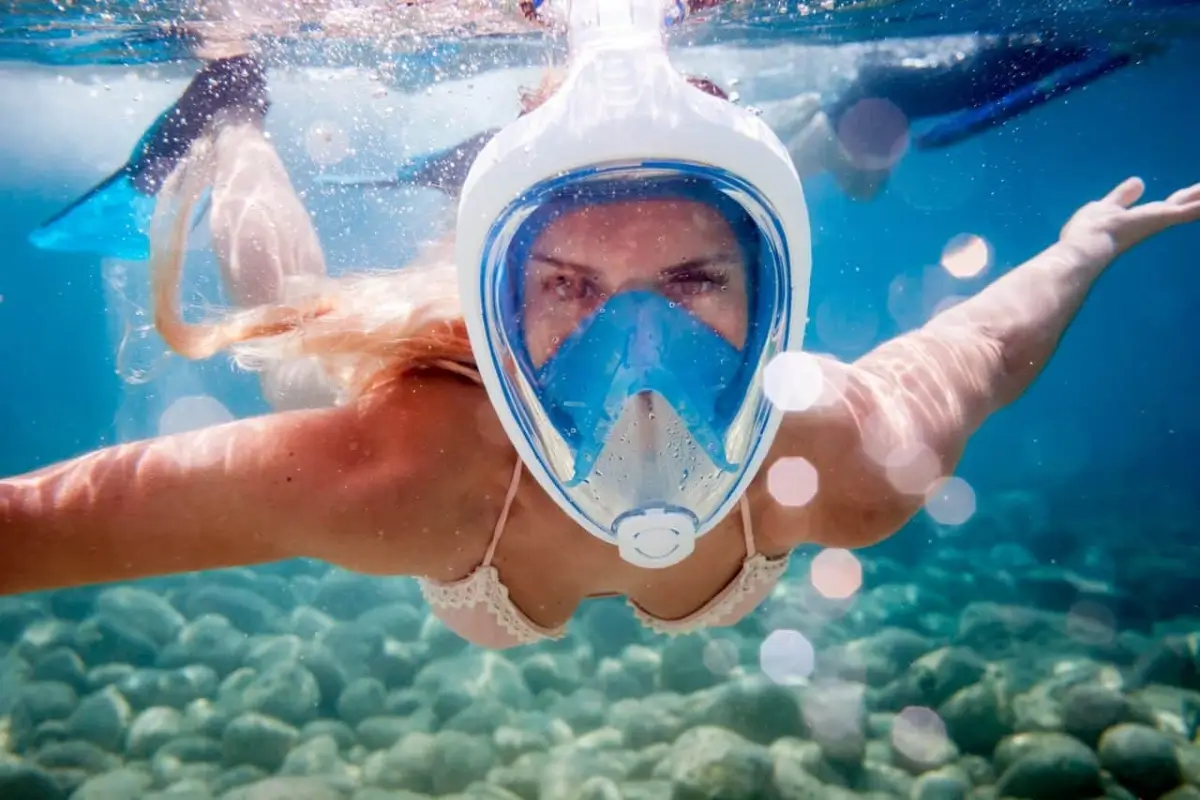When it comes to snorkeling masks, choosing the right one can greatly enhance your experience. Two popular options available in the market are full face snorkel masks and traditional ones. Each has its own advantages and limitations, and understanding them can help you make an informed decision.
In this article, we will explore the pros and cons of full face and traditional snorkel masks, what to consider when choosing snorkeling equipment, compare their visibility capabilities, analyze comfort and fit, and examine the potential risks associated with full face snorkel masks.
Pros and Cons of Full Face Snorkel Masks

Full face snorkel masks have gained popularity in recent years due to their innovative design. These masks cover the entire face, allowing for easy breathing through both the nose and mouth.
Pros
- 360-degree panoramic view
- No fogging due to separate breathing chamber
- More natural breathing experience
- Increased comfort
Cons
- Not suitable for diving or freediving
- May not fit all face shapes and sizes
- Can be more expensive than regular snorkel mask
- May restrict airflow in certain situations
Benefits and Limitations of Traditional Snorkel Mask
Traditional snorkel gear, which consists of a mask and a separate snorkel tube, has been the go-to choice for snorkelers for many years.
Benefits
- Lower cost compared to full face snorkel masks
- Allows for diving and freediving
- Offers a wide range of options and styles
- Easy to find replacement parts
Limitations
- Potential fogging issues
- Less natural breathing experience
- Water may enter the snorkel tube, requiring clearing
- May cause jaw fatigue over extended use
Choosing the Right Snorkeling Equipment
When deciding between a full face and traditional snorkel gear, it’s important to consider several factors:
- Experience Level: Beginners may find full face masks easier to use, while experienced snorkelers may prefer the versatility of traditional gear.
- Water Conditions: If you plan to snorkel in calm, clear waters, both options can work well. However, in rough or windy conditions, traditional snorkel gear may be more suitable.
- Intended Use: If you also enjoy diving or freediving, traditional snorkel gear is a better choice as full face snorkel masks are not designed for these activities.
- Face Shape and Size: Full face snorkel masks may not fit all face shapes, sizes or if you have a facial hair. It’s important to try them on and ensure a proper fit.
- Budget: Full face snorkel masks tend to be more expensive, so consider your budget before making a decision.
Full Face Snorkel Mask vs Traditional: Which Provides Better Visibility?
One of the key factors to consider is visibility. Both options offer different advantages in this regard:
Full Face Snorkel Masks:
- 360-degree panoramic view provides a wider field of vision.
- No fogging due to the separate breathing chamber.
- Less chance of water entering the mask, allowing for uninterrupted viewing.
Traditional Snorkel Gear:
- Mask and snorkel tube can be adjusted independently for optimal fit and comfort.
- Mask design allows for a closer fit, reducing the chance of water leakage.
- Wide range of mask styles available, catering to different preferences.
Comfort and Fit
Comfort and fit are crucial for an enjoyable snorkeling experience. Here’s how they compare in terms of comfort:
Full Face:
- Soft silicone skirt provides a comfortable seal around the face.
- Straps are adjustable for a secure fit.
- Minimal jaw fatigue due to the natural breathing experience.
Traditional:
- Mask and snorkel tube can be adjusted independently for optimal fit.
- Multiple strap options for personalized comfort.
- Potential jaw fatigue over extended use due to the mouthpiece.
Potential Risks of Full Face Snorkel Masks
While good full face snorkel masks offer many advantages, it’s important to be also aware of some potential risks associated with their use:
- CO2 buildup: They can trap exhaled air, leading to an increased concentration of carbon dioxide inside the mask. This can cause dizziness, shortness of breath, and in extreme cases, loss of consciousness. To prevent CO2 buildup, ensure proper ventilation and regularly check the mask’s valves.
- Fit and seal issues: If a full face snorkel mask does not fit properly or creates gaps, water can enter the mask, compromising visibility and breathing. Always follow the manufacturer’s instructions for sizing and fit.
FAQs
Are full face snorkel masks suitable for beginners?
Yes, full face snorkel masks can be a good option for beginners as they provide a more natural breathing experience and offer a wider field of vision.
Can I dive with a full face snorkel mask?
No, full face snorkel masks are not suitable for diving or freediving. They are designed for surface snorkeling only.
Are traditional snorkels prone to fogging?
Traditional snorkels can be prone to fogging due to the limited airflow through the snorkel tube. Using anti-fog solutions or defogging techniques can help mitigate this issue.
Conclusion
When it comes to choosing between a full face and traditional snorkel mask, it ultimately depends on your personal preferences and specific snorkeling needs. Consider factors such as experience level, water conditions, intended use, face shape and size, and budget before making a decision.
If possible, try both options to see which one provides the best fit, comfort, and visibility for your snorkeling adventures.
